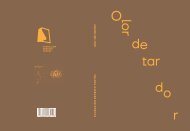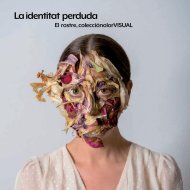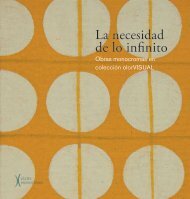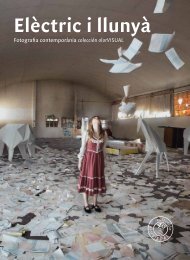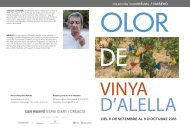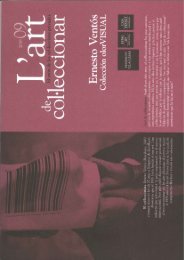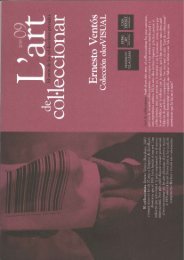You also want an ePaper? Increase the reach of your titles
YUMPU automatically turns print PDFs into web optimized ePapers that Google loves.
Cristina Agàpito<br />
Director-Conservator<br />
colección olorVISUAL<br />
‘But when from a long-distant past nothing<br />
subsists, after the people are <strong>de</strong>ad, after<br />
the things are broken and scattered,<br />
taste and smell alone, more fragile but<br />
more enduring, more unsubstantial, more<br />
persistent, more faithful, remain poised a<br />
long time, like souls, remembering, waiting,<br />
hoping, amid the ruins of all the rest;<br />
and bear unflinchingly, in the tiny and<br />
almost impalpable drop of their essence,<br />
the vast structure of recollection.’<br />
[Marcel Proust, In Search of Lost Time]<br />
The quote from Marcel Proust is an excellent<br />
introduction to explaining the<br />
origin and essence of this project, created<br />
especially for the Municipal Museum<br />
in Málaga as the latest in the series that<br />
started at the Museu <strong>de</strong> Cadaqués (Girona)<br />
in 2013 and continued at the Museu<br />
d’Art in Cerdanyola (Barcelona) in 2014.<br />
The exhibition project Smell of Málaga<br />
has been conceived and created on the<br />
basis of the city itself and its historical<br />
places and events, through the olfactory<br />
memories that these have left us and<br />
the classification of these memories by<br />
means of olfactory notes – the primary<br />
alphabet of the creators of essences<br />
– and the interpretation of the whole<br />
with works from colección olorVISUAL.<br />
Málaga has a long history. Foun<strong>de</strong>d<br />
by the Phoenicians in the 8th century<br />
BCE, it is one of the ol<strong>de</strong>st cities in Europe.<br />
To run through its history in broad<br />
outline, we might say that the city was<br />
part of the Roman Empire, was a prosperous<br />
medina in Moorish Al-Andalus<br />
– and a capital city for a time – and was<br />
incorporated into the kingdom of Castile<br />
in 1487. In the nineteenth century<br />
it achieved prominence thanks to its industrial<br />
activity.<br />
There are several mottos and titles that<br />
<strong>de</strong>fine it for its historical facts: The first<br />
in the danger of Liberty, the most Noble,<br />
most Loyal, most Hospitable, most Charitable<br />
and always Brave City of Málaga.<br />
It has been popularly referred to as la<br />
bella, ‘the beautiful’, and is known by<br />
the nickname of la bombonera, ‘the box<br />
of sweets’, on account of its topography<br />
and situation, ringed by mountains.<br />
No history of Málaga would be complete<br />
without those characters, many<br />
of them anonymous, who have plied<br />
tra<strong>de</strong>s – some now vanished, but others<br />
still alive – that often strike visitors<br />
to the city as curious.<br />
The exhibition is articulated in three<br />
areas, which tell the story of Málaga<br />
and its customs, or at least some of the<br />
many: the Roman presence and its legacy,<br />
the city’s popular characters, and<br />
industrialisation.<br />
Garum or garo: the Roman Empire<br />
leaves a mark<br />
Olfactory notes: Marine / Saltpetre /<br />
Rural-Herbaceous<br />
An indispensable product in all the best<br />
Roman kitchens, garum was a condiment<br />
used to enhance the meal and<br />
intensify the flavour of other foods. It<br />
can be <strong>de</strong>fined as basically a compound<br />
of fatty pelagic fish (sardines, sprats,<br />
mackerel, tuna …), to which were ad<strong>de</strong>d<br />
the innards of other large fish and plenty<br />
of salt, and the mixture was then left<br />
to macerate in the summer sun. In some<br />
variants, layers of aromatic herbs were<br />
ad<strong>de</strong>d. Stirred frequently, it turned<br />
into a liquid, which was subsequently<br />
allowed to filter though a <strong>de</strong>nsely woven<br />
basket, which resulted on the one<br />
hand in a very aromatic translucent fluid<br />
with an amber colour and a salty flavour,<br />
and on the other a <strong>de</strong>nse paste. It<br />
was used as a substitute for salt, and<br />
was also frequently mixed with wine,<br />
vinegar, oil or water.<br />
Along with the perfumes, garum was,<br />
by weight, the most prized – and expensive<br />
–substance in everyday use in the<br />
Roman Empire. In addition to its nutritional<br />
function, it was credited with the<br />
ability to whet the appetite and to aid<br />
digestion. An effective means of preserving<br />
meat or fruit, it was also used<br />
to dispel unpleasant domestic odours,<br />
as well as being an ingredient in medicine<br />
and cosmetics.<br />
We are referring here to salty, humid,<br />
marine, herbaceous odours … I perceive<br />
this whole process through the smells<br />
and the visual artworks of colección<br />
olorVISUAL, letting myself be transported<br />
by several senses. The pits of<br />
the Roman factories where garum was<br />
produced could be associated with the<br />
works by Juan Olivares and Carlos Bunga:<br />
<strong>de</strong>limitations, grids … I get the salty<br />
tang with the vi<strong>de</strong>o by Muntadas, and<br />
the look of garum during the process of<br />
its elaboration is figured in the paintings<br />
of Thomas Werner, Herbert Hamak<br />
and Helmut Dorner. The aromatic<br />
herbs sometimes ad<strong>de</strong>d to it are symbolised<br />
by the drawing by Antonio Tocornal<br />
and the sculpture by Joan Cera.<br />
Popular symbols: the biznaga, the cenachero<br />
and the espetada<br />
Olfactory notes: White flowers / Marine<br />
/ Smoky-Cresolic<br />
The Malagan biznaga is a bouquet<br />
of jasmine in the shape of a ball, the<br />
products of a laborious preparation.<br />
The skeleton of the flower, a wild thistle<br />
known as a nerdo, is collected, still<br />
green, before the summer. The nerdo is<br />
stripped of its leaves and stalks to leave<br />
only the main stem and the spines and<br />
is allowed to dry until it turns a beige<br />
colour and har<strong>de</strong>ns. The jasmines are<br />
collected early on summer evenings,<br />
before they open, and are carefully inserted<br />
one by one onto the spines.<br />
In addition to its beauty and perfume,<br />
the biznaga is also said to drive away<br />
mosquitoes. It is the flower that symbolises<br />
the city.<br />
The biznaguero is a popular personage<br />
who sells biznagas, which are carried<br />
on a leaf of prickly pear, in the streets<br />
of Málaga in summer.<br />
We can say that it smells of tuberose,<br />
ylang-ylang, acacia, gar<strong>de</strong>nia, magnolia,<br />
jasmine and lily-of-the-valley,<br />
assuming the olfactory note that represents<br />
this tradition: white flowers.<br />
Bearing in mind these scents, and the<br />
biznaga flower, I am referred to it by<br />
Javier Campano, Toni Catany, Maggie<br />
Car<strong>de</strong>lús, Julião Sarmento and Riita<br />
Päivälánen, whose works are very diverse<br />
in their characteristics. Its beauty<br />
and subtlety I find in the artistic expressions<br />
of Lorenzo Cambin, Joan Hernán<strong>de</strong>z<br />
Pijuan, Anna Malagrida. Its perfume<br />
is captured in the photography of Lola<br />
Guerrera.<br />
The cenachero, who plied a typical tra<strong>de</strong><br />
that originated in the nineteenth<br />
century and lasted up until the middle<br />
of the twentieth, was a true icon of the<br />
city. They were street peddlers of fish,<br />
especially of the anchovies known as<br />
vitorianos, but also of any other product<br />
of the coastal waters of the Málaga<br />
of the time. Remembered as strong,<br />
well-built men, they wore a sash and<br />
carried their wares hanging from both<br />
arms, and would cry out to the housewives<br />
‘Niña, los vitorianos’ and other<br />
similar phrases as they walked the<br />
streets of the city.<br />
Marine tang, algae, fresh fish: smells<br />
and colours that are transmitted in the<br />
works of Alberto Corazón and Enrique<br />
Brinkmann, signifying the bundles<br />
of fresh fish for sale. Dennis Hollingsworth,<br />
Hugo Fontela, Agustín Ibarrola<br />
and Stephen Dean communicate that<br />
smell of fish, of the sea, and at the same<br />
time the power of the cenachero’s resonant<br />
cries.<br />
All along the coast of Málaga, one of the<br />
most wi<strong>de</strong>spread recollections must be<br />
the smell of sardines grilling slowly on<br />
the glowing embers of a wood fire on<br />
the beach. The sea breeze, the smoke,<br />
and the heat of summer are an explosion<br />
of olfactory memory. The key motif<br />
here is the espeto or the espetada:<br />
the skewer and the skewering central<br />
to the art of grilling fish, which goes<br />
back to the time of the Phoenicians,<br />
and passed on by way of Romans and<br />
Arabs, taking advantage of the beached<br />
boats as windbreaks for the sea breeze.<br />
The espetero is the person responsible<br />
for skewering the fish, impaling them<br />
on split canes and grilling them over<br />
embers of olive and almond wood, paying<br />
close attention to the wind to regulate<br />
the cooking process. This traditional<br />
open-air <strong>de</strong>licacy is just as popular today.<br />
Hannah Collins and her photograph Sardines,<br />
perhaps the most visual work<br />
of the whole project, almost literally<br />
brings the smell of fish to my nostrils.<br />
Bianca Beck, Bernhard Martin, Anne-<br />
Lise Coste and Bernardí Roig summon<br />
the smell of burning and the cooking<br />
of the sea’s fruits, mixed with the salty<br />
breeze of the beach. Smoky, cresolic, coniferous<br />
and fishy smells.<br />
Industrialisation and tra<strong>de</strong>: the mo<strong>de</strong>rnisation<br />
of the city<br />
Olfactory notes: Metallic / Dusty / Tobacco<br />
/ Honeyed-Sugary<br />
During the first half of the nineteenth<br />
century, Málaga was at the forefront of<br />
industrial <strong>de</strong>velopment in Spain, second<br />
only to Catalonia, its pioneering industrialisation<br />
financed by agriculture and<br />
tra<strong>de</strong>. This really took off in 1826 with<br />
the creation of two companies for iron<br />
smelting and casting to meet the <strong>de</strong>mand<br />
for iron fittings in the manufacture<br />
of the casks used in the bottling of<br />
wine and the packaging of agricultural<br />
products for export.<br />
After a difficult start, satisfactory results<br />
were obtained in 1831, when the<br />
La Concepción company built new tall<br />
furnaces to replace the original low<br />
furnaces, and puddling furnaces with<br />
which to obtain the optimum quality of<br />
finished products.<br />
Smells of steel, iron, copper, brass,<br />
bronze and oxi<strong>de</strong> are the effluvia that<br />
come to my memory when this type of<br />
industry is talked about. Clare Langan,<br />
Koenraad Dedobbeleer, Pello Irazu, Jordi<br />
Colomer, Chakaia Booker and the pictorial<br />
sculpture by Michiel Ceulers all refer<br />
us to fire, metal, force, dirt … elements<br />
associated with these processes.<br />
But it was not only the metal foundries<br />
that put Málaga on the industrial<br />
map. Mills for the manufacture of<br />
yarns and fabrics in cotton, linen and<br />
hemp also had an important role. Industrial<br />
Málagueña, S.A. employed as<br />
many as 1,500 people, mostly women,<br />
in its workshops, offices, warehouses,<br />
repair shops and workers housing, and<br />
in due course a second textile factory,<br />
La Aurora, opened.<br />
Smells of cotton flower, wind, chalk, are<br />
among the characteristics of the olfactory<br />
note that represents the manufacture<br />
of spun yarns. The spinners feature<br />
in the vi<strong>de</strong>o by Gabriela Gerosa,<br />
and the looms figure in the sculpture by<br />
Alfredo Álvarez-Plágaro. Enzo Mianes<br />
represents the manufacturing of the<br />
products, while the plaster sculpture<br />
by Alex Jasch seeks to <strong>de</strong>pict the dust<br />
thrown up by all the bustling activity of<br />
these factories.<br />
The Málaga tobacco factory was built<br />
between 1923 and 1927, though it was<br />
not officially inaugurated until September<br />
1934, after a further three years of<br />
modification in or<strong>de</strong>r to increase their<br />
capacity and expand the range of<br />
Spanish products with new lines capable<br />
of gaining a share in different markets.<br />
The Málaga factory was a pioneer<br />
in this regard, with the introduction<br />
of mo<strong>de</strong>rn technologies that set new<br />
standards in the tobacco industry of<br />
the twentieth century. These advances,<br />
which were introduced into every<br />
stage of the manufacturing process, allowed<br />
the factory to produce inexpensive<br />
quality cigars that could rival those<br />
from the Canary Islands and Cuba. For<br />
all of these reasons, the Tabacalera tobacco<br />
company consi<strong>de</strong>red the Málaga<br />
factory as a critical factor in its competitive<br />
strategy.<br />
Woody, pipe tobacco, ash and burnt<br />
wood are smells that evoke the tobacco<br />
factory, although some of these odours<br />
may be mixed with those that are produced<br />
when the tobacco is lit. Thus,<br />
Fleur Noguera’s vi<strong>de</strong>o, Ángel Alonso’s<br />
sculpture and the symbolism of Chema<br />
Madoz’s photography refer us to<br />
the factory and its production, while<br />
Douglas Gordon, Eulàlia Valldosera,<br />
Pamen Pereira, José Luis Pascual and<br />
David Nash transmit the finished product<br />
and the aromas emanating from its<br />
consumption.<br />
Thanks to its subtropical climate, the<br />
coast of Malaga and Granada was a<br />
crucial area for the cultivation of sugarcane,<br />
which generated a sugar industry<br />
of enormous importance. The Málaga<br />
seaboard was known as the Sugarcane<br />
Coast, and the province had a consi<strong>de</strong>rable<br />
number of sugar mills and factories,<br />
many of them in operation since<br />
the sixteenth century. Sugar production<br />
in the province reached 115,000<br />
tonnes a year by the end of the 1960s.<br />
For the zafra, the harvesting of the sugarcane,<br />
the sector employed thousands<br />
of day-labourers known as mon<strong>de</strong>ros.<br />
Their job was to strip the canes, cleaning<br />
off the leaves, and they laboured at<br />
their hard, hot, punishing work from<br />
sunrise to sunset, their eyes scorched<br />
by the burning leaves, their clothes and<br />
skin impregnated with soot and molasses<br />
from the cane.<br />
Sugarcane cultivation and the sugar<br />
industry went into <strong>de</strong>cline in the nineteen<br />
sixties and has now disappeared.<br />
Its former sites have been occupied by<br />
the tourism-based property boom and<br />
by other crops such as avocado and<br />
mango.<br />
Smell of honey, of sugar, of sweetness.<br />
In evoking the sugar industry,<br />
the smells we remember are always<br />
pleasant, and this is shown us by the<br />
paintings of Ángela <strong>de</strong> la Cruz and Ruth<br />
Morán or the photography of Duane<br />
Michals. However, the production process,<br />
especially in the years to which<br />
we have referred, was hard, and this is<br />
interpreted with the paintings of Fernando<br />
Sinaga, Guillermo Pfaff and Robert<br />
Pan, whose colours make us think<br />
of the smells impregnating the skin and<br />
clothes of the day-labourers during the<br />
zafra: burnt and molasses.<br />
I hope that this selection of some of the<br />
historical moments and customs that<br />
have particularly caught my attention<br />
as locally specific may be to the liking<br />
of the people of Málaga. The interpretation<br />
of these things by means of works<br />
of art is always personal, secon<strong>de</strong>d by<br />
the complicity of smells that we recall<br />
without being conscious of it, but that<br />
are there, filed away.<br />
The sense of smell is profoundly subjective<br />
and the most ethereal of all. Smells<br />
have been and continue to between us,<br />
without being. Anchored in memory yet<br />
transient, they represent the evanescence<br />
of existence and the possibility<br />
of eternity. colección olorVISUAL communicates<br />
these i<strong>de</strong>as and allows our<br />
olfactory memory to awaken our most<br />
intimate memories … Let’s have a sniff!




